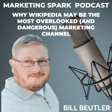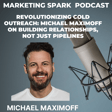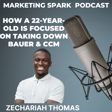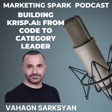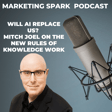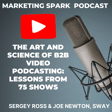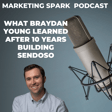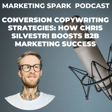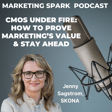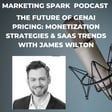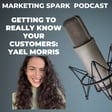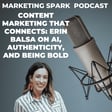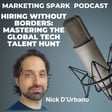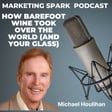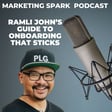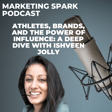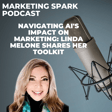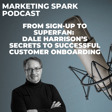Introduction to Marketing Spark Podcast
00:00:09
Speaker
It's Mark Evans and welcome to the Marketing Spark podcast. Before we get started, I want to put the spotlight on a few new developments. Number one, I recently published the second edition of my book Marketing Spark, a guide slash workbook on how to do storage and marketing. It features insight into best practices, worksheet and tools.
00:00:31
Speaker
and you can check it out on Amazon.com and Amazon.ca.
New Service: The 90-day Sprint
00:00:35
Speaker
Second, I just launched a new package called the 90-day Sprint that's designed to help B2B and SaaS companies quickly seize new marketing opportunities and address their biggest challenges. Visit MarketingSpark.co to learn more.
The Role of Brand Positioning in Competitive Markets
00:00:50
Speaker
Now to the podcast. I spend a lot of time, probably too much time, talking about the importance of brand positioning and messaging.
00:00:57
Speaker
In a competitive world, if you're not clear about what you do and how you serve the people who matter to you, you risk blending into the crowd.
Guest Introduction: Alison Litteri on Product Positioning
00:01:08
Speaker
And today I'm excited to be talking with Alison Litteri, who recently published a book, Stand Out Startup, that looks at how a startup can do better product positioning and messaging. Welcome to Marketing Spark. Thank you so much for having me, Mark.
00:01:23
Speaker
Let's kick things off by telling me about your book, Startup Standout, and what inspired you to write it.
00:01:30
Speaker
I wrote Stand Out Startup, the founder's guide to irresistible marketing that fuels growth, really is a guidebook for early stage startup leaders, founders, even marketers who need to figure out the best way to create messaging that appeals to their ideal audience and high converting content.
Challenges in Startup Messaging and Marketing
00:01:48
Speaker
What I've found is that many founders become their first product marketer, whether they plan on it or not.
00:01:55
Speaker
They're the ones who are creating the first investors deck. They're the ones who have to create the copy for the first website, and they often feel like a fish out of water. They know how to describe the technical features of their product, but they're not really sure what process to follow to create a high-converting website and to tell their story.
00:02:14
Speaker
And so in my career as a marketer, building marketing functions and really leading product marketing at fast growing startups, I had the chance to use the skillset multiple times, like launching mobile payments for Intuit at a time when people were still very concerned about tapping their card or putting it into a mobile card reader. So how did we message that to make people feel safe and secure? Also more recently, working at Handshake.
00:02:40
Speaker
really helping the company differentiate our student-focused recruiting platform from LinkedIn, which was more focused on mid-career job seekers. So I knew how important the skill set was. And when I transitioned to advising two years ago, I was actually somewhat surprised to see that this was the thing that was tripping up startups over. And so I decided to write the book because I was
00:03:07
Speaker
taking founders through a process that was very effective at creating messaging and content. And so I really wanted to write it down in one comprehensive place. But I also wanted to get it into the hands of more startup leaders that I know I won't be able to work with, but who need the right process to follow. And I felt like I could really help accelerate their marketing with a
Importance of Messaging for Companies
00:03:29
Speaker
book like this. In the book, you say the biggest thing standing in the way of a startup's growth is often messaging, not product. And as somebody who spends a lot of time
00:03:37
Speaker
focused on content and the importance of messaging and positioning. It totally makes sense to me. I come across a lot of companies and websites and the messaging is confusing, incoherent and uninspiring. And as a result, it turns people off as opposed to turning them on.
00:03:56
Speaker
And I'm curious about why messaging is such a big problem or challenge for so many companies because people like you and me look at this as a no brainer. But for a lot of entrepreneurs, it's something that they continue to struggle with. Why is that? Messaging is one of the most important customer facing touch points a startup has with their ideal customers.
00:04:21
Speaker
And so what happens once a startup finds product market fit and knows that there's this set of customers who love their product and who are getting a lot of value, the next step is really to go out and acquire more of those customers and then retain them once you have them. And so almost immediately, a founding team is trying to figure out the right way to describe their product in a way that attracts those customers. But as we know, startups move very quickly. The product changes very quickly.
00:04:49
Speaker
And the messaging that you start with is not the messaging that will carry you through sometimes even the whole first year of your startup and sales. And so I say in the book that messaging is a really essential founder skillset because there are so many times in the growth of a company that you will need to adjust, whether it's for a specific feature launch or actually repositioning the entire product. And that can happen simply because your team is really great. They're launching new features and the product is becoming stronger.
00:05:18
Speaker
And so you need a new way to describe that value. So customers really get it. It can also happen because your competition changes. And I actually see a lot of companies who were very innovative and unique at the beginning when they launched, but then copycats come in or other competitors shift. And now they need new ways to explain how they're differentiated and customer needs change over time too. So this becomes a pinch point and a company really needs to set itself up to iterate.
00:05:48
Speaker
and keep their messaging fresh so that they can attract the right customers and get them to convert.
Strategy vs Tactics for B2B and SaaS Companies
00:05:55
Speaker
We'll dive into positioning and personality and persona. I wanted to take a step back and look at a fundamental problem, at least something that I run to on a regular basis, is
00:06:07
Speaker
that many technical founders of B2B and SaaS companies struggle with strategy and putting a plan in place. I always say that you plan the work and then you work the plan.
00:06:19
Speaker
But I find in my experience that a lot of companies, especially early stage companies are so anxious to drive leads and brand awareness and sales that they lean hard into tactics. And in the process, they skip over or pay little attention to putting together a marketing strategy.
00:06:38
Speaker
And I'm wondering what your thoughts are about that topic and what are some of the most important high value changes that early stage B2B founders or SaaS founders can make to their marketing strategies?
00:06:52
Speaker
I see the exact same thing happening, this jumping to tactics. And lots of times my first conversations with the founder is, I know I need to be getting more leads on LinkedIn. How do I do that? Or I know I need a PR strategy. Where do I start? And I think part of this comes from founders not having a framework or having an understanding of how to put together the pieces of a marketing strategy.
00:07:15
Speaker
So they go go straight really to lead gen, how do I get more customers, I've heard of these channels that can help me do that. And when you jump straight to lead gen, you really missed the opportunity to think about the full funnel and create a smarter more efficient marketing strategy so
00:07:32
Speaker
That's one thing that I work with founders on is really using a very simple but powerful framework to think about the entire strategy. And what I advise is think about the five phases of a customer journey. So start with how are you going to attract net new customers into your product? How do you capture the attention of your ideal customer and make them know that your product is available and hook their interest so that they're open to learning more?
00:08:00
Speaker
And then the second phase is really nurturing. So now that you have their attention, what is the experience and what's the set of content steps that you're going to take someone through to really make them understand why your product is better for them and create that desire. And certainly in a B2B company, that's warming them up for a really great sales conversation that comes in the next phase.
00:08:24
Speaker
which is convert. So now that you have someone's attention and there's preference for your product, what are you doing to close that sale or get that sign up? And then the two phases of the funnel that often are overlooked, I think in the early days are once you have a customer,
00:08:41
Speaker
Step four is how do you onboard them effectively so that you can accelerate time to value, create that stickiness with your product, and also really help them understand how to use the product over time so they become a long-term customer. And then stage five is really engage. So hopefully this is the longest phase that a founder and a company needs to think through.
00:09:03
Speaker
But what are you doing to deepen engagement with your product, help your customers get more value, and ultimately renew, expand, retain? And so even just having that five-stage funnel in mind and thinking, where do I need to focus most right now? Where is there friction? Or where are we behind most in our metrics?
00:09:24
Speaker
And what are the channels we can use and the content we can create to really increase conversion at each of those stages? That gives the technical founder more of a frame for thinking about all of the pieces and how they fit together. In theory, that sounds great. And as a fellow marketer, I like methodologies. I like the path or the journey that a company or a founder can follow.
00:09:47
Speaker
But one of the challenges and the pushback that I'll give here is that marketing in theory from a high level seems great and walking through these steps with you sounds amazing. But for early stage companies where every marketing dollar counts, where every dollar counts,
00:10:05
Speaker
how do they allocate budget or how much budget should they allocate to capture the attention, to write great content, to onboard properly? Because one of the things I run into is that they're excited to get started with marketing, but sometimes I lose fact of the, well, the side of the reality that you have to spend money to make money. And that, yes, you can hire a marketing consultant, but they're going to tell you things and make you do things that are going to require a monetary investment.
00:10:34
Speaker
Yes, you can do grunt work and you can get your people to make things happen. But how do you address that when the reality is that some of these companies may not have a lot of money for marketing or they don't want to spend a lot of money on marketing, but they want all those other things to happen.
00:10:52
Speaker
I really like to help founders think about layering on channels in a very cost effective way. We like to start with the middle of the funnel. Once you have the attention of leads, which may require some money to attract, what do you want them to do?
00:11:08
Speaker
This is where having very effective messaging and a strong website that takes someone through, this is the product, this is who it's for, this is the big outcome we
Cost-effective Marketing Channel Strategies
00:11:18
Speaker
promise, and then these are the benefits of using our product and how it's differentiated from the alternatives. Then these are all the proof points that show that we can deliver this. These are the features that deliver these benefits. These are our customer stories and endorsements.
00:11:34
Speaker
press other proof points that show that we've been able to help customers get this value, and then ultimately leading to a strong call to action, which is likely a sales conversation. But you have to start with, what do you want someone to do once you have their attention? And that doesn't necessarily cost
00:11:52
Speaker
agency time or paid advertising resources that really is just about a team resource allocation how do you spend time doing that and then as i mentioned earlier onboarding sometimes overlooked but make sure once you have a new client new customer you have an effective onboarding plan whether it's with an account manager
00:12:13
Speaker
or through content and other resources that can really get a user up to speed quickly. So once you have that dialed in, once you have your own channels dialed in, then I like to start thinking about how can we layer on earned channels, which are also technically free, but thinking about ways to get the attention of your ideal customers by borrowing other people's audiences or getting in front of them through channels
00:12:37
Speaker
that they already trust and leaders they already trust. So whether it's a media strategy, podcasting, contributed content, SEO is a great earned media channel, but really thinking about what is the content we can create and then share so that we can get eyeballs through these trusted channels. And then really the last layer is paid. So I really encourage companies to wait on paid social advertising
00:13:06
Speaker
trade shows, partnerships, other things where you are going to have to closely monitor costs of acquisition and CAC until you have that middle of funnel and your owned and earned strategy dialed in. Inevitably, you will have to pay and certainly you'll have to pay for people resources, but it will be so much more cost-effective if you think about the middle of the funnel first. That makes sense to me and I think we're perfectly aligned on this. I think the question that I have for you is,
00:13:34
Speaker
When you have a early stage company, and they're looking to drive forward with marketing, low hanging fruit, or at least the stuff that should be prioritized first are it sounds like you and I work off the same script would be
00:13:49
Speaker
brand positioning, messaging, and the website. If you have your customer story down and you've done your customer research and you understand what their needs and interests are and what their aspirations and goals are, then you can create brand positioning and messaging that is empathetic and customer-centric. And then you can take that and apply it to your website. From there,
00:14:12
Speaker
You can start to do pull different levers that will drive the spotlight and pull people into the website. And that's when you tell your story. So essentially what you're saying is get those key pieces in place first, and then you can layer on all the other types of marketing that you want to do. Is that my inaccurate depiction of what you're saying?
00:14:33
Speaker
That's exactly right. We always start with defining the three P's as you mentioned, because without knowing your persona, knowing your positioning and knowing your personality, it's really challenging to answer questions like, is this messaging
00:14:49
Speaker
explaining our product in a way that's valuable to someone who we want to buy it? Or is this messaging really differentiating us from the alternatives that they will consider? Even are we communicating in a way that appeals to them that they'll like and will help us build a relationship? The three P's, the first place to start, and I think all great marketing decisions go back to who is the person you're trying to influence? Who are you trying to provide value to?
00:15:15
Speaker
For a B2B company, you need to start by defining your ICP, who is that ideal customer profile, the company that your product is the best fit for. But you don't sell to companies, you sell to people. And so identifying the buying committee, who is the main decision maker?
00:15:30
Speaker
in the process of buying the product and who is that primary advocate within the company who is going to find out about your product. They're going to likely lead the internal process to get buy-in for using it. And once you know who that person is, I work with companies to figure out
00:15:47
Speaker
what are their pain points and not just the functional pains, not just the jobs to be done, but also the emotional and social challenges that they're facing as a result of not being able to get those jobs done. And you need to know those things because messaging needs to speak to how much better are you going to feel, how much easier are things going to be once you have a product like this in your world.
00:16:10
Speaker
It's accomplishing these tasks, but it's also making your team collaborate more effectively and saving time and relieving stress. So you start with a persona process, and then moving into the positioning process, you really need to understand what are the products that person is considering when they're comparing your product to alternatives.
00:16:33
Speaker
And sometimes I think companies get hung up on what category are we in, do we need to create a category, et cetera. But I say the simplest place to start is really get clear on who are you being evaluated against and what makes your product a better fit for that person than those alternatives.
00:16:52
Speaker
And it's surprising that I find a lot of my clients aren't clear on that or aren't very confident about that before we work on this process. But you need a lot of conviction about what positions you as stronger and what attributes make you the hands down best choice for a customer over the alternatives to be able to make that really prominent and clear on your website and your sales deck and another collateral.
Creating a Messaging Framework
00:17:18
Speaker
So that's the positioning piece.
00:17:19
Speaker
And then once you have those, you can define a brand personality that is very appealing to that customer, builds authority, but also builds connection, and that is this additional X factor that highlights your differentiators.
00:17:35
Speaker
And so when you have those things, you can move into creating a messaging framework that hits on those most important valuable differentiators. And frankly, once you have the messaging, creating an updated website that reflects that messaging, a sales deck that walks through that messaging, and even content that really emphasizes, again, the value of the product, the success stories,
00:17:59
Speaker
It becomes pretty easy because you have all of those key foundational decisions made and pieces in place. I think one of the challenges that I run into as someone who does brand positioning and messaging is quantifying the effectiveness or the success of those exercises. We live in a data-centric world. As marketers, we have
00:18:23
Speaker
increasingly dependent on dashboards to tell us what to do and data influences a lot of our decisions. But I think what we're painfully discovering is that there's some things that you can quantify and some things that you can't and not everything can be measured. And I think one of the biggest challenges that I face when talking to entrepreneurs about the value
00:18:48
Speaker
and the need for positioning and messaging is that sometimes it's not easily measurable, at least not right away. Sometimes it's just a feeling, the idea that you're more confident in the story that you're telling, or that it's just, everyone seems to be excited and rallies around the new story. In your experience, how do you show
00:19:11
Speaker
clients that your work is successful, that it is doing what it needs to do. When you can't point to data and say, hey, look at those KPIs that we established, we've hit them and we've exceeded them. That's a big challenge that you and I face. So what's your approach to that?
00:19:27
Speaker
The good news is I think there are some key metrics that you can point to in messaging and positioning updates. And I agree with you. One that is not as measurable but very important is the strategic confidence that comes from really understanding your three P's,
00:19:44
Speaker
Having messaging that you know will attract and convert your ideal customers and knowing exactly how you're different and better than the competition because that then can flow through all of your key touch points website sales deck etc.
00:20:00
Speaker
Ultimately, any company that's taking on updated messaging or repositioning really wants to be able to acquire more customers or more effectively acquire customers and retain customers at a higher rate. And we know age-old attribution challenges. It's hard to know, did marketing contribute to that or exclusively own that? Or what's the combination of forces that increased our acquisition and increased our retention?
00:20:28
Speaker
The metrics that I like to use are at two ends of a spectrum. One is measuring shifts in brand perception over time. So usually that can be attributed to improved messaging and positioning, and then a product that actually delivers on those promises. What I like to do is a brand tracker survey that quarterly, or at least two or three times a year, measures and surveys ideal customers and ask them certain things about do they perceive your product?
00:20:58
Speaker
and several top competitive products, how do they perceive them on certain dimensions? Are you delivering this more effectively than some of the alternatives? What are you most known for? And I'll say as an example at Handshake, we really wanted students to know that Handshake
00:21:16
Speaker
was the best place for employers to find them. Less about searching for jobs, but more about employers coming and actively recruiting them on the platform. And that was not a message that we tried to stand for or a value prop that we'd really emphasize before. And over the course of a year, through marketing, collateral, product changes, we were really able to move from students not thinking about that at all to really believing that was one of the main reasons to sign up for Handshake.
00:21:46
Speaker
So you can track those things over the course of a year and over the course of time through a brand tracker. And then at the other end of the spectrum, you can really focus on did certain messaging in a specific marketing campaign or program.
00:22:02
Speaker
drive more active use of a certain feature or increase conversion. And so an example of this would be sending an email that reflects updated messaging and seeing if customers who engage with that email or prospects who engage with that email convert at a higher rate than prospects who don't engage with email at all or who engage with the older messaging. And as part of the messaging development process,
00:22:27
Speaker
I do encourage companies to do testing to make sure that this new messaging you're planning to roll out shows a material difference in active use or changes behavior, but it is possible to measure behavior change at that more micro campaign level. Curious about how you test messaging because obviously there's different ways that you can do it. You can run some down or dirty.
00:22:51
Speaker
paid advertising campaigns, you can create some landing pages, feature your new messaging and your new value propositions. What are some of the other tools that you have at your disposal that you use to test messaging?
00:23:03
Speaker
Those are great ones. I think the first step is really talking to customers and sharing concepts and just getting a gut reaction to messaging, especially if you're making significant changes around the way you're describing some of the features or what your product can deliver. And it's amazing how in just a week or two of conversations with a handful of customers,
00:23:26
Speaker
you can quickly see if your new messages are appealing and making someone's eyes light up and making them more engaged in the conversation or not. Another part of this is you can have the sales team create just very lightweight changes in their sales deck or even one pagers and follow-up collateral and measure increase in follow-up conversations or willingness to continue in the sales process.
00:23:50
Speaker
Generally, you can see a pretty quick change in behavior there without having to totally overhaul the sales process. That's more qualitative, but from a quantitative perspective, companies have great success running paid ad tests, especially if you already have that infrastructure set up. It's an amazing way to be able to test a lot of messages at once, but here's something that's very important. There's a difference between messages that capture attention
00:24:17
Speaker
and help you get on the radar of someone who hasn't heard about your product or engaged before and messages that nurture, right? So once you have someone in your marketing universe, are you sharing information that gets them closer and closer to feeling like your product is the right one for them and they want to buy? So you need to be careful that a hook that really stops someone's scroll and captured their attention and converts them to come to your website, that might be different from
00:24:45
Speaker
testing an email with different subject lines or content within the email that then proves to move that prospect closer to a sales conversation. I have one client that recently told me she had only been doing cold calls. Technical founder, it was a great place to start to attract new customers. So her company's in the energy tech space and they have a new platform to increase sales of the companies that they sell to.
00:25:15
Speaker
Once she created this inbound content motion, the proof for her was that leads that were coming in through inbound content were converting at a much higher rate than leads that were coming in through these cold calls. And so that demonstrated to her that the content was really warming people up for these conversations. And they already had a better sense for why this product was a better fit than people who she was reaching out to without any of the messaging.
00:25:43
Speaker
We can shift gears a little bit, or maybe just sidle over to another topic and talk about what you see as the essential criteria for a strong value proposition.
Developing a Compelling Value Proposition
00:25:52
Speaker
When we're talking about positioning and messaging, sometimes we're talking about boiling down the ocean, about what you do, who you serve, why
00:26:00
Speaker
you deliver value or how you deliver value and how you're unique. And the powerful value proposition to make that happen and change the dynamic of your marketing and your sales. Can you walk me through the criteria that you consider or the methodology that you have? And then again, how do you know that you've nailed your value proposition, that you've got something that you can rally around and go into leveraging your marketing and your sales?
00:26:24
Speaker
I like to think about a messaging framework in three parts. So there's your unique selling proposition. What's the headline about what your product is, who it's for, and the big outcome that it will deliver? So this is your USP. And then that's supported by three value propositions. So what are the biggest benefits of using your product and the reason that you deliver that outcome in a better way than the alternatives for this customer?
00:26:51
Speaker
And then the third part of the framework is really the proof points that show your product delivers those value propositions and that a customer will get the value that you've promised. And so when it comes to a great value proposition, I list eight criteria in the book that I think are really powerful.
00:27:08
Speaker
So the first is the phrase should be results oriented. What is the benefit of using the product? And generally, if you start with either an action verb or a superlative, it will help you get there. It saves time. It increases revenue. It generates affinity.
00:27:27
Speaker
So thinking about a results-oriented statement. And then the second piece is it needs to be feature focused. So one of the best proof points for your value propositions is that you have features that deliver that value. And so as you think about rolling out campaigns and messaging over time, you want your features to reinforce the value you're delivering. So I mentioned that example earlier from Handshake. Over time, we were rolling out more and more features that helped
00:27:57
Speaker
employers find students more effectively. And so one of our value props was around finding students. And as we rolled out new features, we could show our customers that those new features were reinforcing that value prop. So think about what are my main features and do they support at least one of these three value props that I'm creating?
00:28:19
Speaker
And then the next piece is they need to be desirable. So these need to be things that are very valuable to your customers that solve the pain or deliver one of the gains that they're looking for.
00:28:31
Speaker
then they need to be differentiated. So if you read these value props on a competitor's website and it described their product perfectly, then you've missed the mark because you really need your value props to set your product apart and show that using your product delivers benefits in a unique way or delivers more benefit than the alternatives.
00:28:55
Speaker
The third and fourth thing are really important are the next two things. They need to be durable. You don't want to be changing your messaging framework all the time because it makes it more memorable in your customer's mind if they're hearing some of the top value props reiterated. Of course, you will need to update as material things change with your product competition or customers. But think over the next six months and make sure that these value props reflect where your product is going and the value you deliver.
00:29:22
Speaker
But they also need to be defensible. So think about, is this something that my competitor could easily replicate? Or you have a sense that they're going to be delivering this and make sure that you're creating value props that are not easy, easily replicable so that they stand the test of time. And then the last two gut checks are, are these distinct? So if you only have three value props, you want to make sure that they're each working hard and say something different.
00:29:49
Speaker
so that you're really maximizing the messages you can get across while staying within this three-part framework. And then finally, comprehensive. So as you step back and think about, if these were the only three messages that my customers remembered about the product, would this make it clear why they should choose our product and how it will deliver value and why they should choose us over the competition? So that's the list of criteria. They're very interrelated, but I find that if you
00:30:19
Speaker
set out creating value props with those in mind and then evaluate against those criteria, they really lead you to value props that stand out and stand above. Another market area that I want to ask you about is that
Content Marketing for B2B and SaaS: Evolution and Strategy
00:30:34
Speaker
Many B2B and SaaS companies have leveraged content marketing over the last 10 years. It's been the way that they have educated, engaged, and arguably entertained prospects and customers. And for a long time, that was a recipe for success. If you created content that, quote unquote, deliver value or insight,
00:30:57
Speaker
Then it was a way of positioning your brand as a go-to resource and to drive brand awareness and thought leadership. The game has changed in the past year with the launch of chat GPT in that it has made it easy to create and scale content. Now, I would argue that the content isn't that good and that
00:31:18
Speaker
chat GPT and janitor of AI are not shortcuts. But a couple of questions here. One is, in your mind, do you think that content marketing can be an effective tool, continue to be an effective tool for BDB and SaaS companies? And then how you define, everyone talks about value these days. But you talk to a guy like Ross Simmons, who's a very well-known content marketer and it's about value.
00:31:48
Speaker
But my pushback to him and to other marketing leaders is how do you define value? Because to one type of customer's value could be in-depth guides and to other types of customers that could be listicles that are easy to consume. Two-part question here. One, do you think content marketing is still a key and valuable tool for B2B and SaaS companies? And two, how do you define value when it comes to content marketing?
00:32:16
Speaker
I think content marketing is essential, especially as I'm working with early stage startups that are starting from scratch in creating their marketing strategy. Content plays a role in both attracting new leads, but also really moving them forward in the buying process. And so I like to think about creating a content strategy in three parts.
00:32:37
Speaker
It has to start with laying the foundation with your three P's and your messaging. So first, you really need to know who are you talking to? How are you different and better? What is the personality that you use to communicate consistently? And what are those key messages? But then you need to think about what content do you need to create to move a person from one phase of the customer journey to the next? And without content, frankly, you're making your sales team work too hard.
00:33:05
Speaker
They're coming into a conversation where someone doesn't know much about your product. You haven't helped shape their thinking around what's different and valuable. And you also are potentially doing way too much to go out and prospect to find leads without having leads discover and come to you. So step one is understand what part of the customer journey you need to influence.
00:33:27
Speaker
and prioritize that and again to attract leads it's really about compelling hooks that speak to a problem or symptom that they're having that makes them think
00:33:37
Speaker
Huh, I want to know more about this. It feels like this could address something I'm dealing with. Or the nurture phase, which is really showing and proving that you deliver value and you do it in a better way than your competition. So that's part one. Part two is really thinking about a core content calendar. What content, and this gets to your value question, what content can you create that is meaningful to your customer and answers questions they have, anticipates
00:34:05
Speaker
what they're going to need to move forward in the buying process, and that's timely and relevant. So as you think about each quarter of the year, what are seasonal milestones that are on your customer's minds or your prospect's minds?
00:34:20
Speaker
what's happening in their businesses that they care a lot about, whether it's peak season for them, or it's a time of year where sales will be slow and they might be doing more internal work. So really being aware of what's on their mind and will grab their attention. And then deciding what intentional pieces of content you'll create that will help that customer move forward, but also peaks their interests based on what's happening externally.
00:34:47
Speaker
And then the third part is really thinking about channel distribution. So you've got these core pieces of content that can help move someone forward in the sales process. But rather than thinking channel by channel, what do I create for LinkedIn? What types of paid ads do I create?
00:35:04
Speaker
What do I say at the panel at my next conference? Really think about how you can take that core content and splice it up, distribute it in different ways. So for instance, I'm working with one climate tech company that's come up with an assessment to help companies figure out where they are on the path to net zero. That content is an incredible nurture piece. It lives on their website and they pull people into it, but they've also spliced it up into hooks for paid ads on LinkedIn.
00:35:34
Speaker
It's been the source of multiple posts on LinkedIn, just organic social. They have had a webinar that they hosted speaking specifically about the steps of the assessment. And so that piece of content has helped them do a lot of things to bring in more prospects and nurture them. So I would say value at its root is what addresses a customer question or a prospect's question and moves them forward towards making a decision.
00:36:03
Speaker
Just wanted to circle back on the promotion angle because it's one thing to create valuable content. It's another thing to get eyeballs on that content. And I think one of the realities of chat GPT is there's way more content than there used to be six months ago or a year ago. Companies are pumping out content these days and it's a very noisy landscape. You just look, for example, all LinkedIn.
00:36:31
Speaker
and the number of creators that are generating so much content that it's a tsunami these days. So how do you get people to actually become aware of the content that your clients are publishing? It's one thing to put on different channels and slice and dice it, but when you're in a competitive marketplace, how do you stand out from the crowd when it comes to actually getting people to actually to read it or
Tailoring Content Promotion to Customer Needs
00:36:57
Speaker
consume it? I really encourage companies to obsess over
00:37:01
Speaker
what their ideal customer wants to consume and where you can find those people. So there's no one size fits all content strategy. It really boils down to who are you trying to talk to within a company and what is the experience you want to lead them through to the point that they're talking to your sales team. So as an example,
00:37:22
Speaker
I'm working with a diversity, equity and inclusion company who's the main person who they need to talk to is a director of DEI or learning and development within a company. But they also need to get on the radar of the chief HR or people officer as the decision maker in a process.
00:37:39
Speaker
And so they created again, very important reports and data and other content that was interesting to a company that figures out why their tool is better than other DEI training services. But then
00:37:55
Speaker
For the directors, they were creating webinars and experiences and putting that out on LinkedIn and reaching out to very specific people to pull them in to register for those conferences. Whereas the HR decision makers, the chiefs, were not necessarily going to sit on a webinar for an hour in the middle of the day. And so inviting them into special experiences at conferences that were a bit more exclusive
00:38:19
Speaker
or dinners or other things that really help them feel like they'll be in a group of thought leaders and will learn a lot during that time. Two different but related strategies and really have nothing to do with
00:38:33
Speaker
what are the expansive set of channels we could go after? It's really what is important and the best way to get on the radar of this specific person and what is the information that they need in order to understand the value this product can provide, the results we can provide for their employees and why we're a better fit than the alternatives. Card a lot of ground in the last 43 minutes. Thank you for that.
Conclusion and Contact Information
00:38:58
Speaker
Final question is where can people learn more about you and of course your new book.
00:39:03
Speaker
You can visit my website, alisonletary.com backslash growth. And I have some great free resources that overview the process of creating your three P's and strong messaging. So I'd encourage you to go there. Please reach out to me on LinkedIn. We can connect there, Alison Letteri. And also you can find my book, Stand Out Startup on Amazon.
00:39:26
Speaker
Thanks, Alison, and thanks for listening to another episode of Marketing Spark. If you enjoyed the conversation, rate it and subscribe via Apple Podcasts, Spotify, or your favorite podcast app, and share via social media.
00:39:37
Speaker
If you're a B2B or a SaaS company looking for more demand, pipeline, and revenue, but struggling to do marketing that makes an impact, we should talk about my fractional CMO services and my new 90-day marketing sprint package. Reach out to me via email, mark at markevans.ca. Connect with me on LinkedIn or visit marketingspark.co. I'll talk to you soon.

